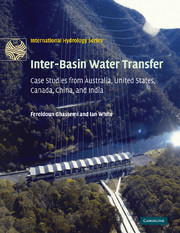Book contents
- Frontmatter
- Contents
- Foreword
- Overview and Scope
- Acknowledgements
- List of Abbreviations
- Part I The Challenges
- Part II Inter-basin Water Transfer in Australia
- 3 Land and water resources of Australia
- 4 The Snowy Mountains hydro-electric scheme
- 5 Inter-basin water transfer from coastal basins of New South Wales
- 6 The Bradfield and Reid schemes in Queensland
- 7 Three schemes for flooding Lake Eyre
- 8 The Goldfields pipeline scheme of Western Australia
- 9 Supplying Perth, Western Australia with water: the Kimberley pipeline scheme
- 10 Other schemes in Australia
- Part III Inter-basin Water Transfer in Other Selected Countries
- Part IV Appendices
- Glossary
- Index
- References
3 - Land and water resources of Australia
Published online by Cambridge University Press: 05 November 2009
- Frontmatter
- Contents
- Foreword
- Overview and Scope
- Acknowledgements
- List of Abbreviations
- Part I The Challenges
- Part II Inter-basin Water Transfer in Australia
- 3 Land and water resources of Australia
- 4 The Snowy Mountains hydro-electric scheme
- 5 Inter-basin water transfer from coastal basins of New South Wales
- 6 The Bradfield and Reid schemes in Queensland
- 7 Three schemes for flooding Lake Eyre
- 8 The Goldfields pipeline scheme of Western Australia
- 9 Supplying Perth, Western Australia with water: the Kimberley pipeline scheme
- 10 Other schemes in Australia
- Part III Inter-basin Water Transfer in Other Selected Countries
- Part IV Appendices
- Glossary
- Index
- References
Summary
GEOGRAPHY
The Australian landmass covers 7 682 300 km2, with maximum dimensions of 3680 km from north to south and 4000 km from east to west. The area of Australia is as great as that of the United States of America (excluding Alaska), about 50 percent greater than Europe (excluding the former Soviet Union) and 32 times greater than the United Kingdom. Australia is the lowest and flattest of the continents. The average surface altitude is only 300 m above mean sea level. Approximately 87 percent of the landmass has an altitude of less than 500 m and 99.5 percent is less than 1000 m. The present topography is due to a long landscape history that started in the Permian period (about 290 million years ago) when much of Australia was glaciated by a huge icecap. After the ice melted, parts of the continent subsided and were covered by sediments to form numerous sedimentary basins, including the Great Artesian Basin. About 55 million years ago, Australia started to drift northward, moving from a position adjacent to Antarctica.
Australia is divided into three physiographic units (Figure 3.1). These are (Australian Geographic Society, 1988):
The Eastern Highlands Belt extends along the east coast of Australia and is a series of ranges of varying height and includes the main divide of the Great Dividing Range. The divide passes through Australia's highest point, Mt Kosciuszko, with an elevation of 2228 m. The western slopes of the Great Dividing Range are generally gradual, while the eastern descent to coastal lowlands is much steeper.
[…]
- Type
- Chapter
- Information
- Inter-Basin Water TransferCase Studies from Australia, United States, Canada, China and India, pp. 51 - 90Publisher: Cambridge University PressPrint publication year: 2007



